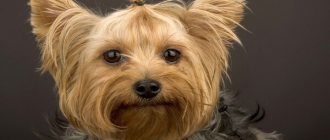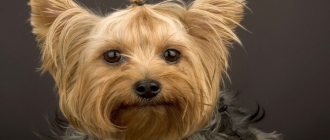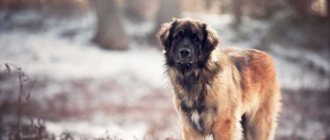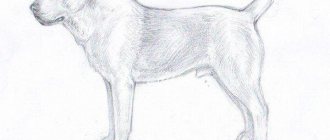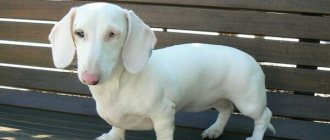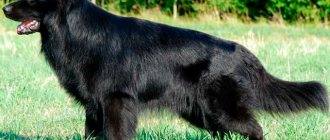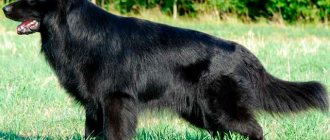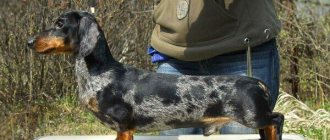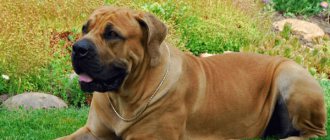The Caucasian Shepherd is a large and powerful guard dog, bred in the Caucasus many centuries ago.
The harsh conditions in which these animals lived and worked, helping to herd livestock and protect them from wolves, developed in them a serious character that required a special approach to training, and appearance features that contributed to survival in high mountain conditions.
Distrustful and even malicious towards strangers, Caucasian Shepherd Dogs are considered one of the best guard dogs.
What are their external features and what should a dog of this breed look like?
Brief history of origin
The Caucasian Shepherd Dog was bred in the Caucasus more than 2500 years ago . Now it would be difficult to name all of its ancestors, however, there is no doubt that Tibetan Great Danes took part in the breeding of these dogs.
Already in ancient times, there was a division of the Caucasian Shepherd breed into varieties, according to their purpose. Those of them who lived in the mountains and were engaged in herding livestock and protecting it from predators were later called Caucasian wolfhounds.
And animals from the foothills and plains living in urban settlements were called Epirus dogs and they were used to guard houses and to participate in military campaigns.
Thanks to the mixture of these two breed types, the Caucasian Shepherd became what it is now: large, brave, strong, equally intolerant of both predatory animals and violators of the territory entrusted to it..
In the first half of the 20th century, these dogs began to be actively bred in nurseries owned by enterprises in the Caucasus and in central Russia.
At that time, this breed was practically not bred by amateurs, and few ordinary dog breeders even simply got a Caucasian Shepherd Dog as a guard for a house or, especially, an apartment.
Most shepherds strive to please people, but this is not typical for this breed..
Caucasian Shepherd Dogs are distinguished by their independent and independent character, which is why their popularity among amateur dog breeders was low in the 20th century.
Everything changed in 1993, when Caucasian Shepherd Dogs unexpectedly gained fans from among non-professional breeders, which led to a surge in the popularity of the breed against the backdrop of deteriorating quality of the livestock.
And only thanks to the fact that at that time many conscientious professional breeders appeared in Russia, the breed was not only preserved, but also continues to improve.
Care
A puppy can grow up healthy and happy only with the proper level of care. Due to their long, fluffy coat, these pets should not miss brushing with a coarse bristle brush two to three times a week. It is necessary to carefully go through the entire coat and, if necessary, trim the pet to avoid the formation of tangles. Nails need to be trimmed once or twice a month.
The puppy needs long walks in the fresh air, which will be accompanied by active games. After each walk, you should check your pet’s ears for the presence of parasites; after inspection, be sure to wipe them with a cotton swab, as this is the most vulnerable part of the Caucasian Shepherd. A balanced diet and regular vaccinations will help your pet always stay healthy.
Breed standard and what purebred dogs look like
Strong and powerful in their own right, these dogs look even larger due to their thick and long coat, which visually gives them additional volume.
The height of a male is from 68 cm with a recommended height of 72-75 cm; females cannot be less than 64 cm, although the ideal height for them is 67-70 cm.
The weight of a male dog should not be less than 50 kg, and that of a female dog should not be less than 45 kg.
This is a dog of a strong or strong rough type of constitution with massive bones and well-developed muscles. The body format is slightly stretched; in males it is usually close to square.
The head has a wide skull and well-developed cheekbones, massive and heavy . The forehead is divided by a shallow groove, the stop is not sharp. The muzzle is shorter than the skull, slightly rounded at the end.
The jaws are strong and deep. The lips are thick and close-fitting, their edges are fully pigmented.
The nose is usually black. But in white and light fawn individuals brown is also allowed.
The eyes are medium-sized, oval, deep-set, brownish.
The ears in their natural state are hanging and set high. Traditionally, the ears of Caucasian Shepherd dogs are cropped short, but this procedure is not considered mandatory and, as a rule, is not carried out in other countries.
The neck is medium in length, powerful, wide and muscular. The withers are well defined, the back is wide, straight and strong, the croup is sloping towards the base of the tail.
The chest is very wide and deep.
The stomach is moderately tucked.
The limbs are parallel, widely set, strong, strong and muscular with well-defined angles of articulation.
The tail is thick, slightly tapered towards the tip. When at rest it is lowered; when working, it is carried over the back in the form of a ring or sickle.
The coat is coarse and straight, with a well-developed thick and dense undercoat, which is usually lighter than the outer coat.
On the head and front sides of the limbs the hair is shorter and tighter. There are featherings on the neck, back of the legs and tail.
Any color except solid black, red-brown (liver) and blue.
The Caucasian Shepherd must have a full set of teeth located in a regular, scissor bite.
How much does a Caucasian Shepherd dog weigh?
The spread in the parameters of this breed between the standard and the real one can be significant and increasing. It is important for the owner that his pet does not go beyond the minimum level.
If the animal’s weight exceeds the maximum, you need to make sure that the dog is really large and not overfed. To do this, compare the parameters of height and volume of the metacarpus. They must also not exceed the standards.
If the difference between real indicators and standard ones is significant, this indicates improper maintenance of the animal (underfeeding or overfeeding), deviations in the health of the animal - the presence of diseases. In these cases, you need to contact an experienced veterinarian.
From birth to 2 weeks
The initial stage of development begins at birth and lasts up to 7 weeks. The birth weight of Caucasians should be between 0.6 and 0.8 kg.
If a newborn kitten weighs less than 600 grams, it is simply naive to hope to get a large dog from it in the future.
An overly large puppy is also not a guarantee of its health. Before purchasing a pet that was born weighing more than 800 g, you must consult a veterinarian about congenital abnormalities in the animal.
Rapid growth in the first weeks of life is ensured by nutritious mother's milk
A newborn litter is small lumps, compact and inactive. They are active only when there is discomfort: experiencing hunger, dampness, cold, or painful sensations. At this time, the chicks have developed taste, smell, vestibular apparatus and skin-temperature reflexes.
Therefore, at first the little Caucasian is helpless, sleeps a lot, and often latches onto his mother’s nipples. The main food for him is milk. If the bitch has good lactation, and the litter is viable, which is expressed in its activity during sucking, then the daily increase from birth to four weeks of age is 113-200 grams.
Caucasians grow rapidly during this period. By two weeks they weigh from 2000 to 3880 g.
1 month
The period from 15 to 30 days is very important for dogs. At this time, auditory and visual perception of the world develops. Puppies begin to learn about objects around them. By this time they can already walk.
The height at the withers for girls should be at least 23-25 cm, for boys - 24-26. Measurements of the metacarpus during this period in females show 8-9 cm. In males, these figures are half a centimeter higher.
One-month-old young animals can already be given liquid complementary foods as an additive to mother's milk. Average weight from 4000 to 6800 grams. Moreover, girls have less mass than boys.
After a month, puppies continue to need mother's milk, but are already receiving their first complementary foods.
2 months
During this period, puppies begin to gain 400-420 grams daily. The weight of a two-month-old Caucasian Shepherd is from 13 to 19.6 kg.
Puppy age 2 months
3 months
For now, Caucasians are still clumsy and clumsy. But they are no longer as compact as newborns. Their limbs become elongated, their neck and torso become more oval, their head and chest enlarge. During this period, the Caucasian Shepherd puppy looks like a small bear cub.
The baby begins to develop conditioned and conditioned-unconditioned reflexes. At this time, it is recommended to begin training your pet, instilling basic skills in it, and teaching it simple basic commands.
He is still growing rapidly, gaining weight, and actively maturing. The daily increase ranges from 200 to 400 grams. A three-month-old puppy should weigh 18-32 kilograms.
The height at the withers according to the standard for females reaches 43-46 centimeters, for males - 45-49 centimeters. The volume of the metacarpus in girls is 11.5-12.5 centimeters, in boys the figures are 1 centimeter higher.
3 months - time to start actively training the puppy
4 months
From the age of three months to six months, the weight of a Caucasian Shepherd puppy should increase three times. During this period, the daily gain varies from 230 grams to 530. The weight of a four-month-old puppy can be 25-60 kilos.
Puppy age 4 months
5 months
The maximum weight of a five-month-old Caucasian is 64 kg, the minimum is 35 kg. It is already acquiring its basic color - the period of juvenile molting is ending.
The teenager's molars begin to grow, and his ears gradually rise. The pet is almost completely similar to an adult.
Puppy age 5 months
6 months
A six-month-old puppy weighs 40-94 kilograms. Its height at the withers reaches 63-68 cm in boys, 59-63 cm in girls. The volume of the metacarpus in females reaches 13-14 cm, in males - 14-15.5 cm. Now its appearance almost completely corresponds to an adult.
At this time, young bitches may begin their first heat. But dog experts and veterinarians do not recommend breeding large breed dogs until they are 2 years old. It is then that the bitch’s body completely matures.
Puppy age 6 months
7 months
After six months, animals grow less actively. In four weeks they gain from 1700 g to 5160 g. Daily gain varies from 57 to 172 g. A seven-month-old Caucasian weighs 41.7-99 kg. According to standards, the norm is 40-70 kilograms of live weight of the animal.
8 months
An eight-month-old individual weighs from 43.4-104.4 kg. The difference between the minimum and maximum indicators is explained by the parental genes, the health of the dog, its maintenance: feeding, used when exercising dogs with physical activity.
9 months
A nine-month-old adolescent shepherd can weigh between 44.8 kilograms and 109.5 kg. This is an almost fully formed individual. The animal is still growing, although not as rapidly as before.
10 months
Most of this breed grows to ten months of age. Having reached it, the pet looks like an adult.
A ten-month-old male dog can weigh a minimum of 46.2 kg, and a maximum of 114.6 kg.
At 10 months, a Caucasian Shepherd puppy looks like an adult
11 months
Some shepherds gain a little weight up to three years of age. This happens because with age, bones become stronger and muscles become denser. Therefore, even with identical volume parameters, the animal turns out to be heavier when weighed. The minimum weight for a male is 47.6 kg, for a female - 38.6.
Year
From six months to a year, the weight of a Caucasian Shepherd dog increases by only a third. The norm for females is 40-115 kg, for males - 50-125 kg.
The height of the Caucasian Shepherd at the withers for males becomes 68-78 cm, for females – 64-72. The volume of the metacarpus in girls reaches 14-15 cm, in boys - 15.5-16.5 cm.
From one to three years
The age of the shepherd is 2 years.
At one and a half years, the puppy’s growth stops, but its weight may increase a little more. According to standards, an adult Caucasian Shepherd weighs 45-50 kg.
But today there are increasingly deviations towards increasing the parameters of representatives of this breed. Very large individuals are often encountered.
Sometimes the weight of an adult Caucasian Shepherd Dog reaches 125 kg. This happens thanks to the selection work of breeders.
Briefly about character and temperament
A very serious breed, distinguished by its aggressive character and willfulness.
Has a tendency to become attached to only one person, while being indifferent to other family members, at best . Not too playful.
As a comrade or, especially, as a nanny for children, it is not recommended, since she does not know how to balance her strength.
NOTE!
She is very aggressive towards strangers who have entered her territory, and it does not matter to her who they are: thieves, a postman, or a neighbor’s kitten who accidentally ran into the yard.
In everyday life, when there is no real or visible threat, the Caucasian Shepherd is calm, reasonable and intelligent..
But due to the fact that these dogs like to make decisions on their own, they are not inclined to follow the owner’s commands immediately, which can create difficulties when training them.
These dogs cannot tolerate rough treatment: this makes them angry and can become uncontrollable . They also do not tolerate being rushed: in this case, the animal generally stops accepting the owner’s orders and seems to switch off for a while.
Adaptation
Even before the dog is home, you should take care of the necessary equipment:
- food bowls;
- drinking bowl;
- basic first aid kit for the animal;
- items for hair care (shampoo, comb, brush, etc.);
- toys for the puppy.
From the first days, you need to start accustoming your pet to a new place. Don't forget to repeat your pet's name often so that he gets used to it. It is useful to call your dog by name before meals.
The adaptation period will be much better if, before taking your pet home, you visit him at the nursery a couple of times.
It would be best to get to know and play with the dog a little so that the baby can get used to you. First of all, when the puppy is at home, you should give him something to drink and familiarize him with his surroundings. The dog will act restless at first, this is normal. We need to help the animal adapt and treat this with understanding.
It is recommended to talk to the puppy calmly, without raising your voice, so as not to scare the baby. Most of all, the future owner should have direct contact with the animal. A Caucasian Shepherd puppy should know its owner and not strive to take a leading position.
Popular types
Based on the type of coat, Caucasian Shepherd Dogs are divided into long-haired, intermediate-haired and short-haired.
In total there are the following types of this dog breed::
- Shorthair . They are distinguished by their extraordinary courage and at the same time aggressiveness; they are not afraid to fight a wolf alone. However, due to the fact that their coat is shorter than that of the standard variety, they do not tolerate extreme cold very well.
- Smooth-haired . Due to the very short undercoat, they resemble Central Asian Shepherds in appearance.
- Stepnaya . Bred mainly in Azerbaijan and Dagestan. It is distinguished by a lighter type of build and high legs. They are famous for their speed and swiftness. As a rule, their short fur is colored in reddish shades.
- North Caucasian . It is distinguished by physical strength, endurance and the ability to adapt to the most difficult weather conditions. The character is characterized by decisiveness, distrust of strangers and independence in decision-making.
- Bald . In the 70-80s of the 20th century, the so-called hairless Caucasian Shepherd Dogs were bred, whose fur did not exceed 5-6 mm in length. The purpose of breeding a hairless variety was an attempt to adapt the Caucasian Shepherd to urban conditions, since the classic long-haired variety would have too much hair in the apartment, and the dog itself would not be comfortable due to the heat. It is considered a subspecies of short-haired dogs.
The most common colors in dogs of any type are gray, red, fawn, brown and white , brindle and motley Caucasian Shepherds are also found .
Vaccinations
The main goal of vaccination is to develop stable immunity in your pet. Caucasian Shepherd puppies are vaccinated against canine distemper, leptospirosis, parvovirus enteritis, rhinotracheitis, adenoviral hepatitis and rabies.
After vaccination, it is necessary to monitor the pet's condition. In some cases, the following symptoms of the disease may be observed: low activity, loss of appetite, elevated body temperature, general weakness, and unhealthy nasal discharge. Usually, unhealthy symptoms disappear on their own after a couple of days.
If the dog's condition worsens, you should immediately contact a veterinarian.
Photos of the main types of colors
- Grey . Reminiscent of the color of a wolf, it looks like a mixture of dark and light areas, turning into one another.
- Ginger . It comes in varying intensities, from light reddish to rich dark red, close to the color of mahogany.
- Fawn . Lighter than red and not as rich. It can be with or without a mask on the face.
- Brown . Brownish-gray, dark shade. As a rule, it is rarely uniform in lightness.
- White . Pure white or close to light cream coat color.
- Brindle . Brindles of a darker shade are scattered across the main background of fawn, red or grayish tint.
- Motley . Scattered over the main white background are more or spots of any of the above colors.
White markings can be present in any of the solid colors.
What kind of crossbreeds exist?
With a German Shepherd
Large and powerful dogs, in whose appearance features of both breeds can be traced . As a rule, they have lighter bones and a longer muzzle.
The ears can be either drooping or erect, like those of the “Germans”. The coat is long, thick and dense, its color is either solid brown, red, fawn, gray, or black.
By nature, mestizos are more docile and obedient than Caucasian Shepherd Dogs . They are better suited for families with children, as they have a calm, peaceful disposition and are not characterized by aggression and hostility.
With alabai
Large, massive and muscular dogs with a transitional coat between the two breeds.
The color can be any of those inherent in Caucasian or Central Asian shepherd dogs.
They are smart and well trained, but at the same time they are very distrustful of strangers and always jealously guard the territory entrusted to them..
Also read the comparison between the Alabai and the Caucasian Shepherd.
With a husky
Dogs with lighter bones than the Caucasian Shepherd.
They are less aggressive towards strangers and are more active and mobile.
The coat is long and thick, the head is not as heavy and powerful as that of a shepherd . The ears are either drooping or erect unless they are cropped.
With husky
This variety was bred as an experimental breed intended for service in the conditions of Siberia and the Far North.
As a result, what turned out was not at all what was expected: the mestizos demonstrated in every possible way a reluctance to work, they lacked guard instincts, and at the slightest attempt to influence them, they became angry and uncontrollable.
The only advantage of these mestizos was that their appearance, due to their color with a white mask, typical of a husky, turned out to be very interesting.
With St. Bernard
These mestizos are similar to the Moscow Watchdog . Their character is very different from that of St. Bernards: they are distrustful of people and willful, and their training is fraught with a number of difficulties.
At the same time, they are more phlegmatic and balanced than Caucasian Shepherd Dogs.
Metis always inherits features of appearance and character from both parents . It is sometimes impossible to predict in what combinations this happens.
As a rule, mestizos always have thick hair and, in addition, they are distinguished by their large size and muscular build. As for coat color, it is not always inherited from the Caucasian Shepherd.
Appearance of puppies
Puppies of this breed look well-fed, thick-footed and fluffy.
Most of them have short-cropped ears in early childhood, which, combined with round, shortened muzzles, gives the babies a resemblance to bear cubs.
However, despite the charming “toy” appearance, small Caucasian Shepherds from an early age are characterized by an attentive and wary look, typical of adult dogs..
Nutritional Features
The first priority for the owner is to ask the breeder what the dog was fed before. With a sudden change in diet, the puppy may experience digestive problems. Therefore, the transition to a new type of nutrition should be as smooth as possible. The pet should be fed in a designated area. The diet should be balanced in terms of protein, fat and carbohydrates. Don't forget about the vitamins and minerals that your baby needs so much.
It is recommended to feed puppies with premium dry food, a thoughtful homemade diet, or stick to a combination menu. It is recommended to feed a puppy 4-5 times a day; until one year of age, the number of meals decreases and the volume of portions increases. An adult dog eats twice a day. There should always be clean and fresh water in the drinking bowl, which must be changed as needed.
The daily diet of a “Caucasian” directly depends on the viscosity of the feed consistency. With a wet diet (i.e. liquid content 65-80%), the puppy is given 35-45 g of food per 1 kg of weight. If your pet's diet consists of dry food, the food calculation is 10-15 g per 1 kg.
It is prohibited to give puppies the following foods:
- fatty meat (pork);
- tubular bones;
- salty, fried, spicy or smoked foods;
- fish
- sweets
- low quality dry food
- baked goods, fresh bread.
How to choose?
You only need to buy a puppy with documents, since they are not only a guarantee of purebred and conformity of the exterior to the standard, but also evidence that the dog has good heredity and a stable psyche.
When choosing a Caucasian Shepherd puppy, you need to carefully watch the kids and how they play with each other.
It should be remembered that you should only take a puppy with the makings of a leader if you really need a serious guard dog and the future owner is willing to devote a lot of time to its socialization, upbringing and training, sparing neither effort nor money.
But an intimidated puppy hiding behind the backs of his littermates is not the best choice for a layman: he may look unhappy, evoke sympathy and a desire to shelter him, but one must not forget that these dogs are prone to passive aggression and have a temperament unusual for the breed .
After all, the Caucasian Shepherd, first of all, should be brave, not timid.
A puppy with a stable psyche does not show increased aggression, but he is not cowardly either. Such a baby willingly plays with his brothers and sisters, and shows moderate friendliness towards people.
Housing preparation
You should pick up a puppy at the age of 1.5-2 months from birth. Before buying a puppy, it is very important to prepare a personal equipped space for the dog. This could be a spacious outdoor enclosure where the baby can be active and mobile. Your pet must have a kennel so that he can shelter from adverse weather conditions.
There should not be very high structures in the enclosure.
Until the age of four months, “Caucasians” are contraindicated from jumping and running on stairs due to the high likelihood of deformation of the hind limbs and various diseases of the bones and joints. If the pet will be kept at home, then you should also take care of sufficient space and a ventilation system. Don’t forget about the place for your pet to sleep; it should be comfortable and roomy, because the dog will grow very quickly.
